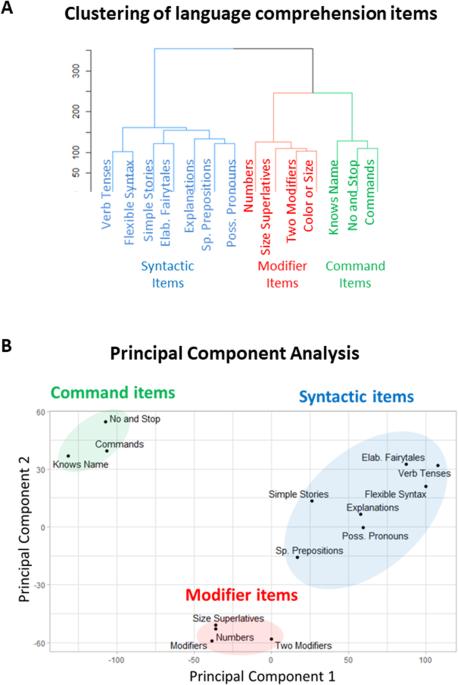Are there distinct levels of language comprehension in autistic individuals – cluster analysis
引用次数: 0
Abstract
Autism is a neurodevelopmental condition characterized by deficits in social communication. We assessed 14-language comprehension abilities in 31,845 autistic individuals 4 to 21 years of age using parent-generated reports. Data-driven cluster analysis identified three distinct levels of language comprehension: (1) individuals in the command-language-phenotype were limited to comprehension of simple commands; (2) individuals in the modifier-language-phenotype showed additional comprehension of color, size, and number modifiers; 3) individuals in the most-advanced syntactic-language-phenotype added comprehension of spatial prepositions, verb tenses, flexible syntax, possessive pronouns, and complex narratives. The observation of three distinct language levels was consistent across different age groups. Autistic individuals’ communication level is currently commonly characterized as nonverbal, minimally-verbal, or verbal. This one-dimensional description is not ideal for characterizing an individual’s communication ability. In fact, a nonverbal individual with syntactic-language-phenotype may have normal ability to communicate albeit nonverbally, while a verbal person with command-language-phenotype does not have a normal ability to communicate by any means. Identification of the three distinct language-comprehension-phenotypes provides an opportunity to enhance characterization of individuals’ communication level. A composite description in terms of both, verbal abilities and a language-comprehension-level, will not only be more precise, but can improve language therapy by focusing it on both aspects of language development.

自闭症患者的语言理解能力是否存在不同程度的差异--聚类分析
自闭症是一种以社交沟通障碍为特征的神经发育性疾病。我们利用家长提供的报告,对 31,845 名 4 至 21 岁自闭症患者的 14 种语言理解能力进行了评估。数据驱动的聚类分析确定了三种不同的语言理解水平:(1)命令语言表型的个体仅限于理解简单的命令;(2)修饰语语言表型的个体显示出对颜色、大小和数字修饰语的额外理解能力;(3)最先进的句法语言表型的个体增加了对空间介词、动词时态、灵活句法、所有格代词和复杂叙述的理解能力。不同年龄段的自闭症患者的语言水平呈现出三个不同的层次。目前,自闭症患者的交流水平通常被描述为非语言、基本语言或语言。这种单一维度的描述对于描述个体的沟通能力并不理想。事实上,具有句法语言表型的非言语型患者可能具有正常的沟通能力,尽管是非言语沟通;而具有命令语言表型的言语型患者则不具有任何正常的沟通能力。识别这三种不同的语言理解表型为进一步描述个人的交流水平提供了机会。从言语能力和语言理解水平两个方面进行综合描述,不仅会更加准确,而且还能通过将重点放在语言发展的两个方面来改进语言治疗。
本文章由计算机程序翻译,如有差异,请以英文原文为准。
求助全文
约1分钟内获得全文
求助全文

 求助内容:
求助内容: 应助结果提醒方式:
应助结果提醒方式:


